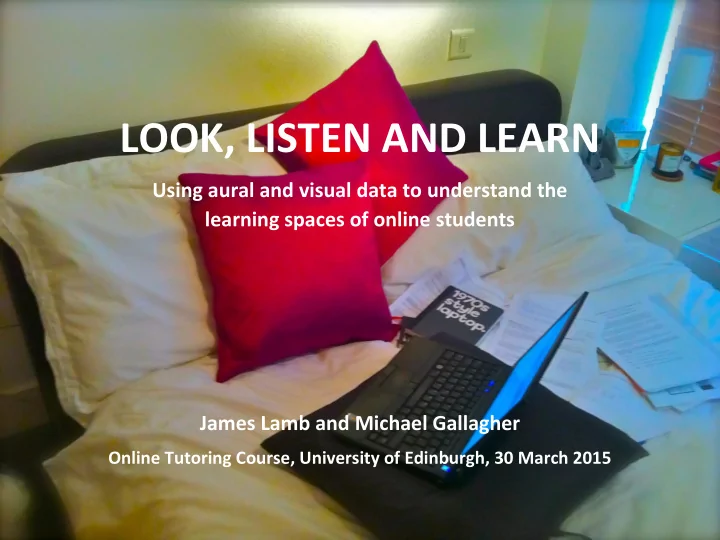

LOOK, LISTEN AND LEARN Using aural and visual data to understand the learning spaces of online students James Lamb and Michael Gallagher Online Tutoring Course, University of Edinburgh, 30 March 2015
What do we really know about the study space of online learners? Kirkwood (2000), Kahu et al. (2014), Moss (2004)
The campus is reconfigured to meet the changing needs and habits of learners
What does it mean to be a student at Edinburgh, but not in Edinburgh? Bayne et al. (2013), Ross et al. (2013) Visit: edinspace.weebly.com. Project funded by Principal’s Teaching Awards Scheme.
What does it mean to be a student at Edinburgh, but not in Edinburgh? View the maps at: edinspace.weebly.com/postcards.html
Transcription and analysis • Avoided the tendency to amongst Internet scholars to privilege image over sound (Sterne 2006) • Visual methodologies with particular attention to image sites and audiencing (Rose 2012 • Sonic methodologies with a particular ear to personal sound space and sonic territory (Fluegge 2011) • A multimodal approach that allowed for the construction of meaning through the interplay of different semiotic material (Kress and van Leeuwen 2001, Jewitt 2009) • We looked for coherence and information linking between different modes (Monaco 2009, van Leeuwen 2004)
Transcription and analysis • Personal sound space (Fluegge) • Territorialism and contested space (Fluegge 2011) • Spatial acoustic self- determination (Fluegge 2011) • Sites of image and audiencing (Rose 2012) • Coherence (Monaco 2009, van Leeuwen 2004)
Josie’s learning space(s)
Josie’s learning space(s)
Aggie’s learning space
Emergent themes 1. The prevalence of informal, homely and domestic spaces – a body of ‘comfort learners’ 2. Attempts to mark out a material and/or aural territory -a corner or haven for personal study 3. Creation of learning space within a shared space (rather than carving out a distinct personal territory) 4. Sonic trespass, where the learning space was penetrated by the intrusion of sound and its material agents 5. A contrast between manufactured silence and sound (including music in attempts at spatial acoustic self- determination
Some concluding thoughts • We need to question preconceptions we might have about the highly technologised and mobile nature of online learning. • Conventional academic resources and tools continue to feature prominently in the learning spaces of what we might see as even the most digital students. • Students configure the aural and material components of their learning spaces in different ways. • As distance educators we need to understand how territoriality is enacted across aural and material planes, and how this in turn influences a student’s engagement with her programme and institution.
References Auinger, S. & Odland, B. (2009). “Reflections on the Sonic Commons.” Leonardo Music Journal , 19, 63–68. Bayne, S.; Gallagher, M.S. & Lamb, J. (2013). Being ‘at’ university: the social topologies of distance students. Higher Education , 67(5), 569- 583. Burn, A., & Parker, D. (2003). Analysing media texts . London: Bloomsbury Publishing. Fenwick, T., Edwards, R. & Sawchuk, P. (2011). Emerging approaches to educational research: tracing the sociomaterial . London: Routledge. Fluegge, E. (2011). The consideration of personal sound space. Journal of Sonic Studies, 1(1). Kahu, E. R., Stephens, C., Zepke, N., & Leach, L. (2014). Space and time to engage: mature-aged distance students learn to fit study into their lives. International Journal of Lifelong Education, 33 (4), 523-540. Kirkwood, A. (2000). Learning at home with information and communication technologies. Distance Education, 21 (2), 248-259. Kress, G. and van Leeuwen, T. (1996, 2006). Reading Images: The Grammar of Visual Design . London: Routledge. Kress, G. and Van Leeuwen, T. (2001). Multimodal Discourse: The Modes and Media of Contemporary Communication . Arnold: London. Jewitt, C. (Ed.). (2009). The Routledge Handbook of Multimodal Analysis (pp. 28-39). London: Routledge. Law, J. & Mol, A. (2001). Situating technoscience: an inquiry into spatialities. Environment and Planning D . (19), 609-621. McKee, H (2006) Sound matters: Notes towards the analysis and design of sound in multimodal webtexts. Computers and Composition , 23, 335-354 Mol, A. & Law, J. (1994). Regions, networks and fluids: anaemia and social topology. Social Studies of Science , 24(4), 641-671. Monaco, J. (2009) How to Read a Film: Movies, Media, Multimedia, 30th anniversary edition. London: Oxford University Press. Moss, D. (2004). Creating space for learning: conceptualizing women and higher education through space and time. Gender and Education , 16 (3), 283-302. Neumark, Norie; Gibson, Ross; van Leeuwen, Theo (2011-11-09). VOICE (Leonardo Book Series). Cambridge MA: MIT Press. Reznikoff I. 2006. The evidence of the use of sound resonance from Palaeolithic to Medieval times. In Archaeoacoustics, ed. C Scarre, G Lawson, pp. 77–84. Cambridge, UK: Cambridge University Press Rose, G. (2012). Visual methodologies: An introduction to researching with visual materials . London: Sage. Ross, J.; Gallagher, M.; Macleod, H. (2013). Making distance visible: assembling nearness in an online distance learning programme. The International Review of Research in Open and Distance Education (IRRODL), 14(4). Samuels, D. W., Meintjes, L., Ochoa, A. M., & Porcello, T. (2010). Soundscapes: Toward a sounded anthropology. Annual Review of Anthropology , 39, 329-345. Sterne, J. (2006). The historiography of cyberculture. Critical cyberculture studies , 17-28. Sterne J. 2003. The Audible Past. Cultural Origins of Sound Reproduction . Durham: Duke University Press. Sterne J. 1997. Sounds like the Mall of America: programmed music and the architectonics of commercial space. Ethnomusicology , 41(1), 22–50. van Leeuwen, T. (2004). Introducing Social Semiotics: An Introductory Textbook . London: Routledge.
James Lamb james.lamb@ed.ac.uk @james858499 www.james858499.net Michael Sean Gallagher gallagher.michaelsean@gmail.com @mseangallagher http://michaelseangallagher.org/ We also have a project that is exploring how music accompanies, influences and inspires learning. Visit www.elernenmuzik.net .
Recommend
More recommend